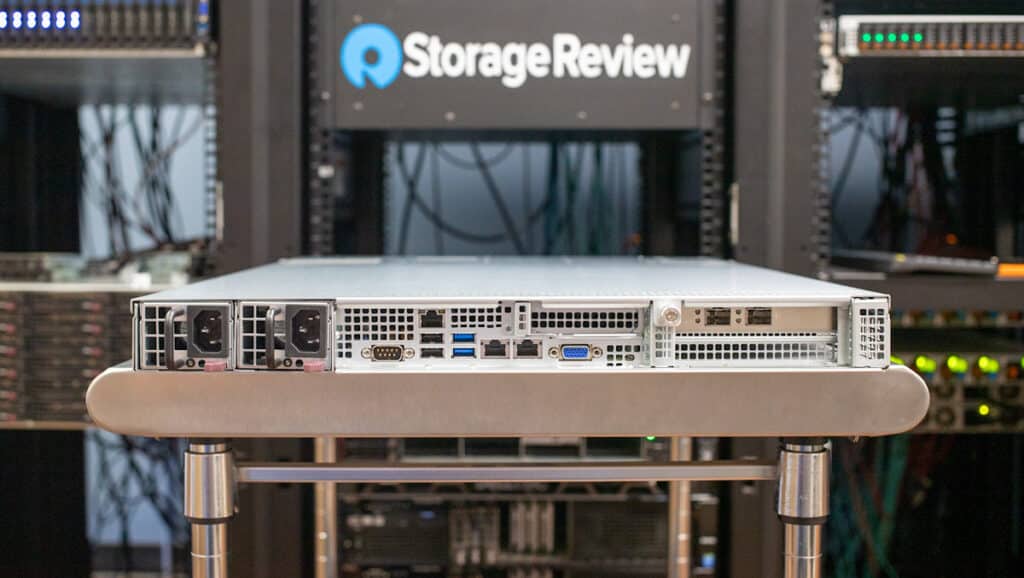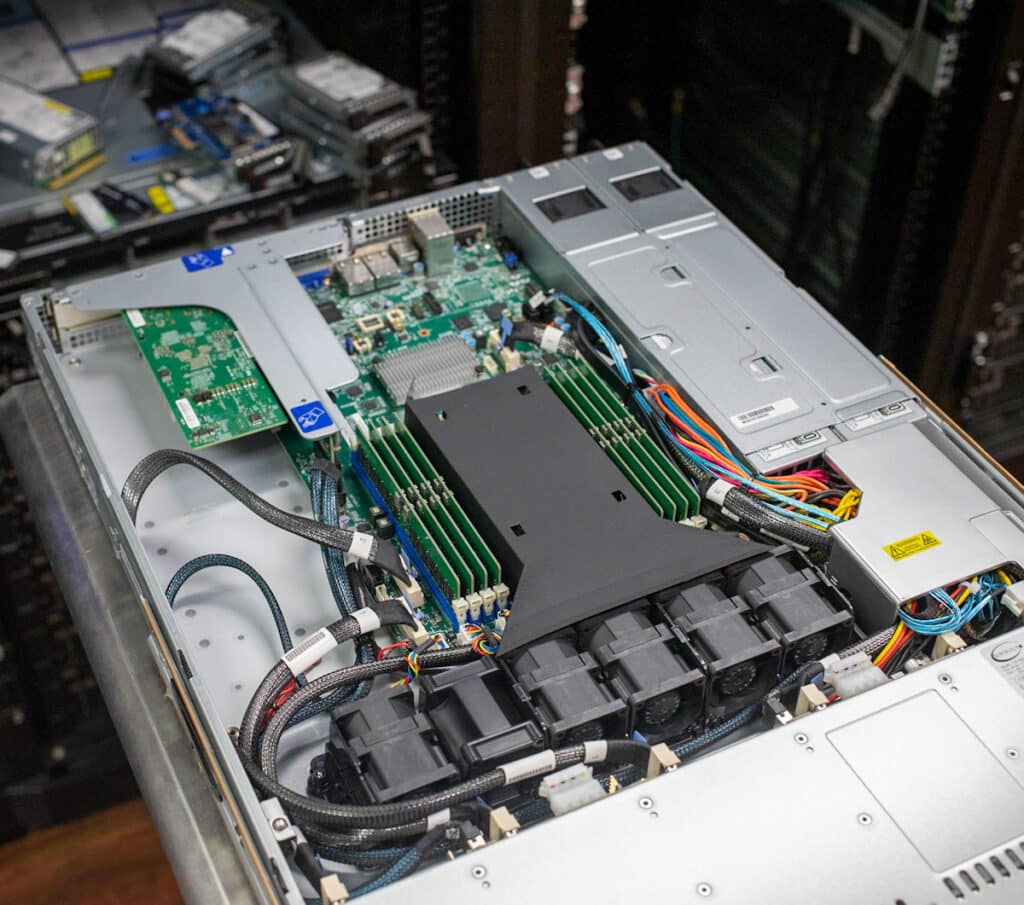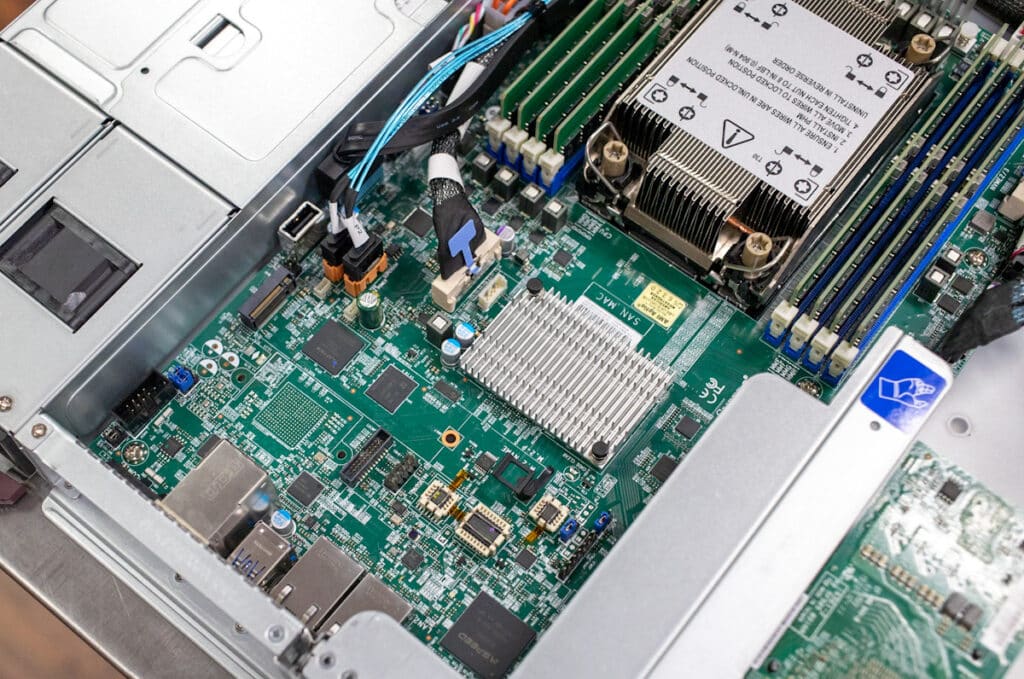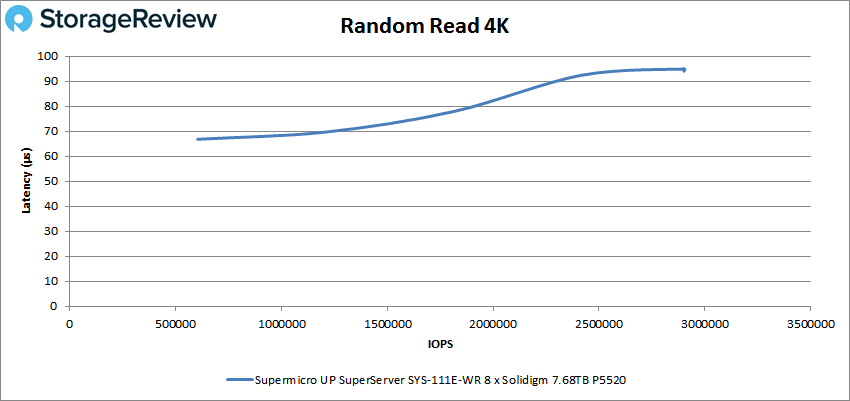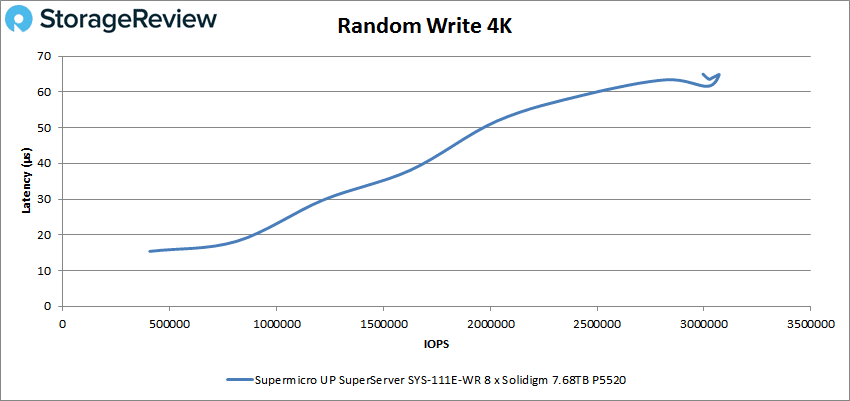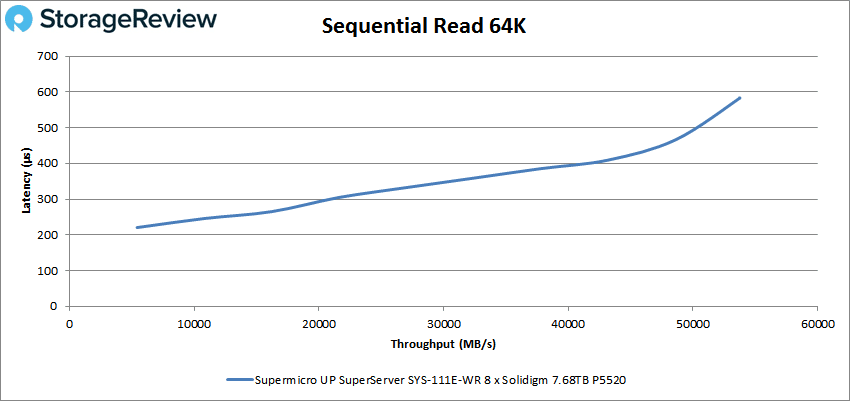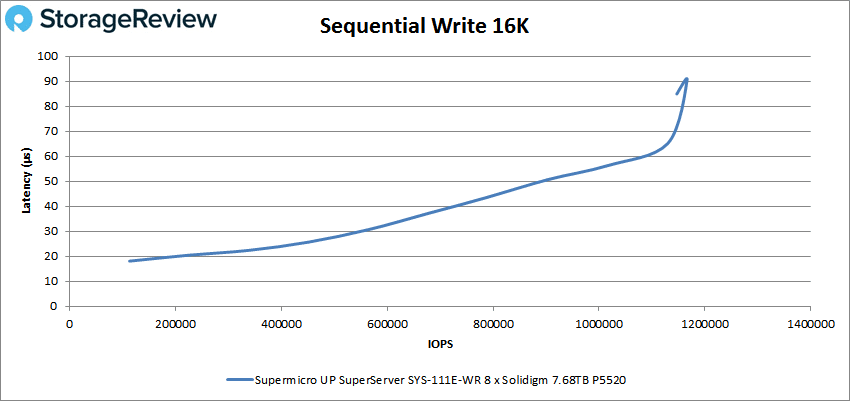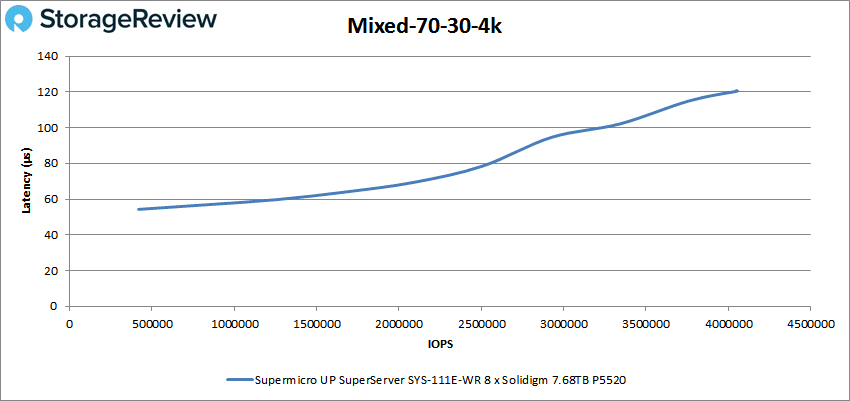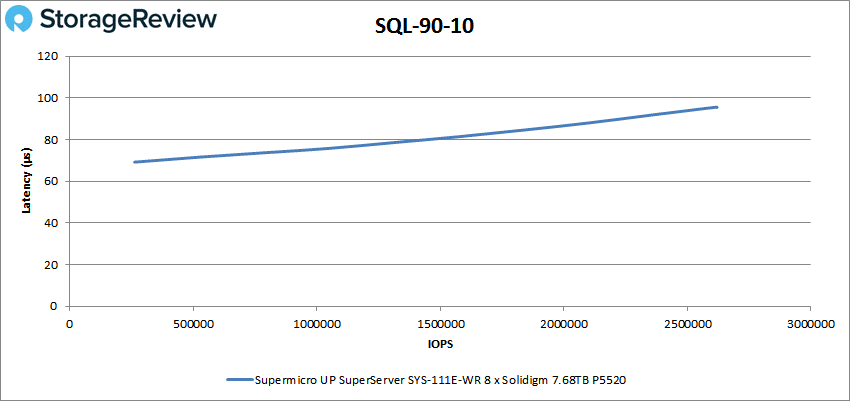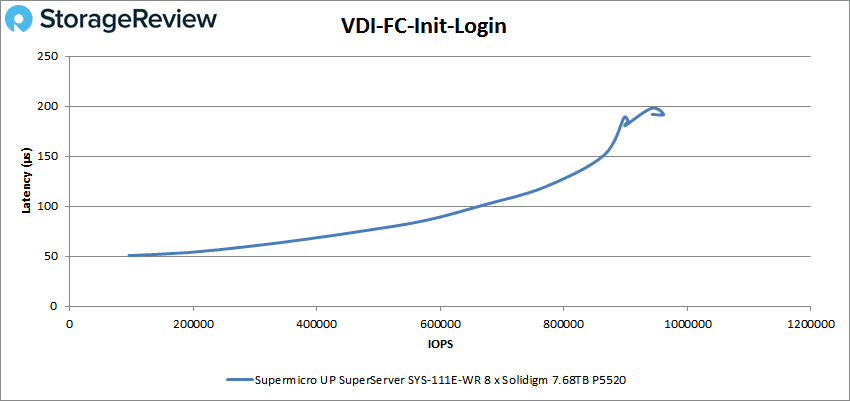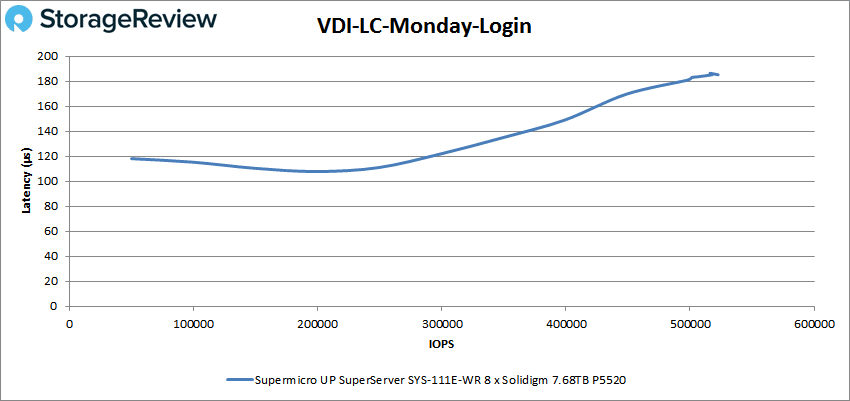The Supermicro SYS-111E-WR server offers an impressive range of features that make it a great option for organizations that need a compact high-performance computing solution. Supporting Intel’s 4th Gen Xeon Scalable Processors (single Socket LGA 4677) and PCIe Gen5 expansion, the SuperServer SYS-111E-WR is capable of handling a variety of workloads ranging from content delivery at the edge to mainstream cloud and virtualization use cases.
The Supermicro SYS-111E-WR server offers an impressive range of features that make it a great option for organizations that need a compact high-performance computing solution. Supporting Intel’s 4th Gen Xeon Scalable Processors (single Socket LGA 4677) and PCIe Gen5 expansion, the SuperServer SYS-111E-WR is capable of handling a variety of workloads ranging from content delivery at the edge to mainstream cloud and virtualization use cases.

The SuperServer’s Super X13SEW-F motherboard features 8 DIMM slots that allow for up to a generous 2TB of DDR5 memory, while the 10 drive bays provide ample storage capacity. The UP SuperServer SYS-111E-WR also supports both NVMe and SATA storage, with onboard RAID 0/1/5/10 support for SATA bays. In terms of connectivity, the system features dual 1GbE BaseT ports with Intel i210 for reliable network performance, four USB 3.2 Gen 1 ports, three USB 2.0 ports, and a VGA port.
One of the more important features of the SuperServer SYS-111E-WR is its support for PCIe Gen5 expansion cards, with 3 slots available for use (two x16 FHFL slot(s), one x8 LP). The system’s SuperDOM (Disk on Module) ports offer additional boot options for added flexibility. The board also has a single Gen3 M.2 NVMe slot for boot.
In terms of management, the SuperServer SYS-111E-WR supports a range of industry-standard tools, including Intelligent Platform Management Interface (IPMI) v.2.0, virtual media over LAN, KVM-over-LAN support, and Redfish API. The system also features PC Health Monitoring for CPU cores, chipset voltages, and memory, along with thermal control for fan connectors.
SuperMicro UP SuperServer SYS-111E-WR Specifications
| Form Factor | 1U Rackmount |
| Enclosure | 437 x 43 x 597mm (17.2″ x 1.7″ x 23.5″) |
| BIOS Type | AMI 32MB SPI Flash EEPROM |
| Processor |
|
| System Memory |
|
| Drive Bays | 10x 2.5″ NVMe/SATA drive bays; 10x 2.5″ NVMe hybrid; |
| Expansion Slots |
|
| On-Board Devices |
|
| Network Connectivity | 2x 1GbE BaseT with Intel i210 |
| IPMI | Support for Intelligent Platform Management Interface v.2.0 IPMI 2.0 with virtual media over LAN and KVM-over-LAN support |
| Input / Output |
|
| Power Supply |
|
| PC Health Monitoring |
|
| Dimensions and Weight |
|
Supermicro SYS-111E-WR Design and Build
The UP SuperServer SYS-111E-WR is of the 1U Rackmount form factor (23.5 inch depth). This compact yet powerful design offers high-density storage capacity, easy manageability, and scalability, making it the great choice for data center applications where density is important.
The front panel of the SuperServer features horizontally stacked drive bays that are hot-swappable and support NVMe/SAS/SATA storage. The status LEDs, power button, UID button, and two USB 3.2 Gen1 ports are located on the right side for easy access.
At the rear of the server, you’ll find a variety of ports and expansion slots, a dedicated BMC LAN port, two legacy USB 2.0 ports, two USB 3.2 Gen1 ports, dual RJ45 1GbE LAN ports, and a VGA port. On the left side are the redundant 860W platinum-level power supplies, while the right houses the three PCIe Gen5 expansion slots: two x16 FHFL slots and one x8 (in x16) LP slot.
Removing the server cover is fairly easy – simply loosen the single captive thumb screw on the top panel, slide it back slightly, and lift it off. Once inside, you’ll see the MBD-X13SEW-F motherboard and a toolless, top-loading riser bracket with FHFL double-width GPU support.
At the front, you will see the five counter-rotating server fans (as well as a slot for an optional 6th fan), allowing for cooling efficiency and reduced noise levels, as counter-rotating fans help cancel out the noise generated by the spinning blades.
Near the middle is the single 4th Gen Intel Xeon scalable processor, which is surrounded by eight DDR5-4800 DIMM slots that support up to a total of 2TB of RAM via (256GB x 8). This review configuration has 256GB of DDR5 DRAM and an Intel Xeon Gold 6414U (32 cores).
The server’s M.2 slot, which supports the PCIe 3.0 x2 interface (M-Key, 2280/22110), is located on the back right of the motherboard. We don’t have one installed in the below picture, but you can see it near the I/O port areas.
Supermicro SYS-111E-WR CPU Performance
Our review system is configured with the following key components for CPU testing:
- 1 x Intel Xeon Gold 6414U
- 8 x 32GB DDR5
- 8 x Solidigm 7.68TB P5520
- Windows Server 2019
Geekbench 5 is a cross-platform benchmark that measures the performance of a system and provides a score for comparison. It is designed to work on multiple platforms and provides a consistent measure of performance across many devices, from smartphones and tablets to desktops and servers.
| Geekbench5 Multi | 31,523 |
| Geekbench 5 Single | 687 |
Cinebench R23 is a widely used benchmarking tool that measures the performance of CPUs and GPUs using Maxon Cinema 4D for rendering, and provides a score that can be used to compare the performance of different systems and components.
| Cinebench R23 Multi | 35767 |
| Cinebench R23 Single | 1012 |
HWBOT x265 Benchmark, hosted on hwbot.org, measures the performance of a system by rendering a video in 1080P or 4K resolution using the x265/HEVC encoder. It is designed to take advantage of modern CPU instruction sets and is optimized for multi-threaded performance for competitive benchmarking.
| HWBOT x256 4k 3x overkill (4K) | 31.528 |
| HWBOT x256 4k 3x overkill (1080p) | 59.739 |
y-cruncher is a multi-threaded and scalable program that can compute Pi and other mathematical constants to trillions of digits. Since its launch in 2009, it has become a popular benchmarking and stress-testing application for overclockers and hardware enthusiasts.
| y-cruncher 1b (1Billion Digits) | 13.069s |
| y-cruncher 10b (10Billion Digits) | 155.858s |
Blender benchmark measures the 3D rendering performance of a CPU or GPU by rendering a 3D scene in the Blender software. It provides a score that can be used to compare the performance of different systems and components.
| Blender CLI CPU Only | |
| Monster | 277.676367 |
| Junkshop | 178.886197 |
| Classroom | 133.516795 |
| Total | 590.079359 |
Supermicro SYS-111E-WR Storage Performance
When it comes to benchmarking storage devices, application testing is best, and synthetic testing comes in second place. While not a perfect representation of actual workloads, synthetic tests do help to baseline storage devices with a repeatability factor that makes it easy to do apples-to-apples comparisons between competing solutions. These workloads offer a range of different testing profiles ranging from “four corners” tests, common database transfer size tests, to trace captures from different VDI environments.
All of these tests leverage the common vdBench workload generator, with a scripting engine to automate and capture results over a large compute testing cluster. This allows us to repeat the same workloads across a wide range of storage devices, including flash arrays and individual storage devices. Our testing process for these benchmarks fills the entire drive surface with data, and then partitions a drive section equal to 25% of the drive capacity to simulate how the drive might respond to application workloads. This is different from full entropy tests which use 100% of the drive and takes them into a steady state. As a result, these figures will reflect higher-sustained write speeds.
We configured the Supermicro UP SuperSErver SYS-11E-WR with eight 7.68TB Solidigm P5520 Gen4 NVME SSDs for our synthetic workload test. The operating system is Ubuntu-22.04.1.
Profiles:
- 4K Random Read: 100% Read, 128 threads, 0-120% iorate
- 4K Random Write: 100% Write, 128 threads, 0-120% iorate
- 16K Sequential Read: 100% Read, 32 threads, 0-120% iorate
- 16K Sequential Write: 100% Write, 16 threads, 0-120% iorate
- 64K Sequential Read: 100% Read, 32 threads, 0-120% iorate
- 64K Sequential Write: 100% Write, 16 threads, 0-120% iorate
- 4K, 8K, and 16K 70R/30W Random Mix, 64 threads, 0-120% iorate
- Synthetic Database: SQL and Oracle
- VDI Full Clone and Linked Clone Traces
Starting off in random 4k reads, the Supermicro UP SuperServer SYS-111E-WR showed a peak performance of 2.9 million IOPS at just 94µs in latency when outfitted with eight Solidigm P5520 7.68TB SSDs.
In writes, the SYS-111E-WR was able to peak at 3.07 million IOPS at 64.8µs before taking a small spike in performance at the very end.
Moving on to 64k sequential performance, the SYS-111E-WR peaked at 53.8GB/s (860K IOPS) read with a latency of 581.7µs with the Solidigm drives.
For 64k sequential writes, the SYS-111E-WR recorded a peak performance of 18.6GB/s (roughly 300K IOPS), where it took a steep spike in latency then dipping, ending at 1,040µs.
In 16K sequential performance, the SYS-111E-WR posted 33.8GB/s (2.16 million IOPS) and 117.3µs in latency for reads.
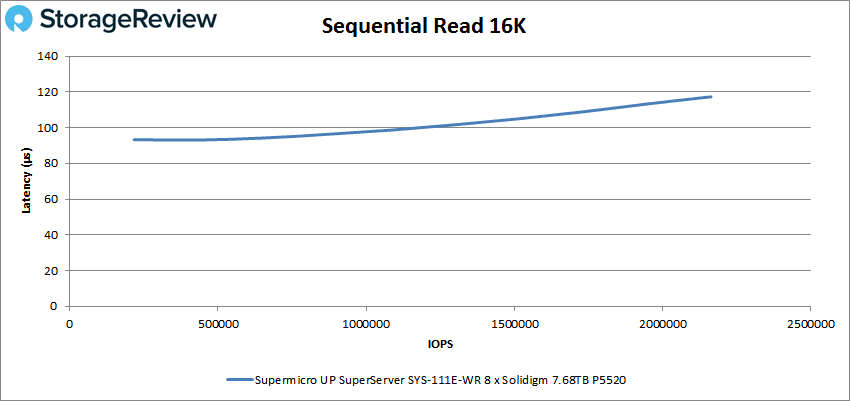
Next up is our mixed workloads, starting with our mixed 70/30 4k profile (70% read, 30% write). Here, the SYS-111E-WR posted a peak of 4.05 million IOPS at 120.5µs in latency.
In our mixed 70/30 16k profile, the Supermicro SYS-111E-WR yielded a peak of 1.9 million IOPS at 232µs in latency when populated with the Solidigm drives.
In our last mixed profile (70/30 8k), the SYS-111E-WR peaked at a solid 2.86 million IOPS with a latency of 168.9µs before taking a slight dip in performance at the very end.
Our next set of tests is our SQL workloads: SQL, SQL 90-10, and SQL 80-20. Starting with SQL, the new Supermicro server posted a peak performance of 2.77 million IOPS with a latency of just 90.5µs with the eight Solidigm drives.

With SQL 80-20, the SYS-111E-WR peaked at 2.46 million IOPS with a latency of just 99.3µs.
Next up are our Oracle workloads: Oracle, Oracle 90-10, and Oracle 80-20. Starting with the general Oracle workload, the SYS-111E-WR had a peak performance of 2.28 million IOPS at 108.5µs.

Next up is Oracle 80-20, where the SYS-111E-WR peaked at 1.98 million IOPS at 86.9µs.
Next, we switched over to our VDI clone test, Full and Linked, where the 9400 continued its great performance. For VDI Full Clone (FC) Boot, Supermicro SYS-111E-WR at 1.93 million IOPS with a latency of 129µs with the Solidigm drives.

With VDI FC Monday Login, the SYS-111E-WR posted a peak of 705K IOPS at a latency of 139.7µs (with a slight blip in IOPS at the very end of the test).
For VDI Linked Clone (LC) Boot, the Supermicro SYS-111E-WR showed steady performance, peaking at 663K IOPS with 159.3µs.

For VDI LC Monday Login, the SYS-111E-WR showed a peak of 522K IOPS with a latency of 185.2µs. This placed it 2nd overall.
Conclusion
The SuperMicro UP SuperServer SYS-111E-WR is a powerful and compact server and an excellent option for businesses and organizations that require a high-performance computing solution in a compact factor. This server supports Intel’s 4th Gen Xeon Scalable Processors and PCIe Gen5 expansion, the latter of which allows businesses to take advantage of the latest-generation storage interface for increased performance.
The SuperServer SYS-111E-WR also supports a range of management tools, including IPMI v.2.0, virtual media over LAN, KVM-over-LAN support, and Redfish API, making it easy to manage and monitor. Additionally, the PC Health Monitoring feature enables monitoring of CPU cores, chipset voltages, and memory, while the thermal control for fan connectors ensures efficient cooling and reliable performance.
To test the performance of the SuperServer SYS-111E-WR, we installed eight Solidigm P5520 SSDs. The results of our benchmarking certainly show that the SuperServer offers excellent performance and is well-suited for data-intensive applications. In VDBench, highlights include 2.9 million IOPS read and 3.07 million IOPS write in our 4k workloads, while hitting 53.8GB/s in 64K read, 18.6GB/s in 64K write, 33.8GB/s read in 16K read, 18.2GB/s in 16K writes, during our sequential workloads. Our mixed 70/30 profiles recorded 4.05 million IOPS in 4K, 2,86 million IOPS in 8K, and 2.9 million IOPS in 16K.
Not all workloads will require this much performance, but with the ten NVMe bays and even the midrange CPU in this build, overall performance is pretty nice. In fact, the SYS-111E-WR is very well positioned for a number of workloads that want to tune hardware for their very specific needs.
Content delivery networks, for instance, would find this box to be a perfect fit for edge distribution. While we used TLC drives in this testing, swapping out for the high-capacity QLC options could deliver over 300TB in 1U. On the enterprise side, the 32-core CPU is positioned nicely so that this system needs a single VMware CPU license, making this a cost-efficient virtualization box. Overall, the SYS-111E-WR delivers an outstanding mix of value and performance for use cases that require a compact, energy-efficient storage server solution.
Engage with StorageReview
Newsletter | YouTube | Podcast iTunes/Spotify | Instagram | Twitter | TikTok | RSS Feed


